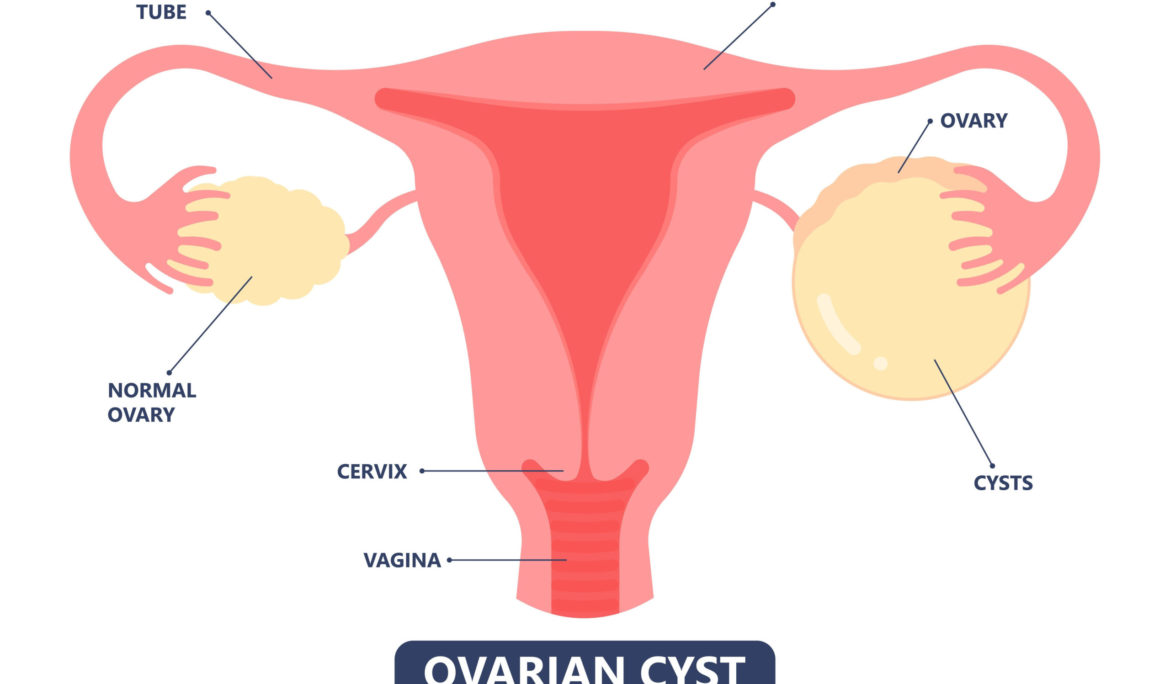Understanding Ovarian Cysts: Symptoms, Causes, and Treatments


Ovarian cysts are a common condition faced by women at some point in their lives. These fluid-filled sacs develop on or inside an ovary and often go unnoticed due to their generally benign nature. However, understanding their symptoms, causes, and treatments is crucial for women’s health. This article provides comprehensive insights into ovarian cysts, helping you navigate this condition with informed choices.
What are Ovarian Cysts?
Ovarian cysts are fluid-filled sacs or pockets that develop either on or within a woman’s ovaries. Often forming during the menstrual cycle, these cysts are usually harmless and may disappear without any treatment. While most ovarian cysts are benign (non-cancerous), they can occasionally cause symptoms like pelvic pain, bloating, or menstrual irregularities. The nature and size of these cysts can vary; some are small and asymptomatic, while others may grow larger and require medical intervention. Ovarian cysts are a common occurrence, particularly during a woman’s childbearing years, and their presence is often detected during routine pelvic examinations or specific symptoms that prompt further investigation.
Symptoms of Ovarian Cysts
The symptoms of ovarian cysts can vary depending on the size, type, and whether they cause complications. Some women with ovarian cysts experience no symptoms at all, particularly when the cysts are small. However, when symptoms do occur, they may include:
- Pelvic Pain: A dull or sharp ache in the lower abdomen on the side of the cyst. This pain may be constant or intermittent.
- Bloating or Swelling: Some women with ovarian cysts experience a feeling of fullness or heaviness in their abdomen.
- Painful Bowel Movements: Cysts can cause discomfort during bowel movements, especially if they are pressing against the bowel.
- Pain During Intercourse: Pain or discomfort during or after sexual intercourse, especially if the cyst is large.
- Menstrual Irregularities: Cysts can affect the menstrual cycle, leading to irregular periods, and heavier or lighter bleeding than usual.
- Urinary Symptoms: Increased urgency or frequency of urination can occur if a cyst is pressing against the bladder.
- Nausea and Vomiting: In some cases, especially if the cyst is large or causes the ovary to twist (ovarian torsion), there can be nausea and vomiting.
- Breast Tenderness: Similar to symptoms experienced during a normal menstrual cycle, some women may have breast tenderness.
- Fullness or Pressure in the Abdomen: Feeling full quickly when eating or a sense of pressure in the abdomen.
- Unexplained Weight Gain: Though less common, some women may experience weight gain.
Causes of Ovarian Cysts
Ovarian cysts can develop due to various reasons, often related to the menstrual cycle or underlying health conditions. Here are some of the primary causes of ovarian cysts:
Hormonal Imbalances:
Functional cysts, the most common type, often form as a result of hormonal fluctuations. For example, during the menstrual cycle, if an egg isn’t released or if the sac — follicle — in which the egg forms doesn’t dissolve after releasing an egg, it can swell with fluid, forming a cyst.
Pregnancy:
Ovarian cysts can occur in early pregnancy until the placenta forms. Sometimes, the cyst that forms when an egg is released, known as the corpus luteum, can become a cyst in the ovary.
Endometriosis:
Women with endometriosis can develop a type of ovarian cyst called an endometrioma. Tissue similar to the lining inside the uterus grows outside of it and can attach to the ovary and form a cyst.
Pelvic Infections:
Severe pelvic infections that spread to the ovaries and fallopian tubes can lead to cyst formation.
Polycystic Ovary Syndrome (PCOS):
PCOS is characterized by many small cysts on the ovaries, caused by an overproduction of hormones, including androgens.
Benign Growths:
Noncancerous growths, like cystadenomas, can develop on the outer surface of the ovaries and turn into cysts.
Previous Ovarian Cyst:
If you’ve had one ovarian cyst, you’re at increased risk of developing another.
Hormone Therapy:
The use of fertility drugs to induce ovulation can sometimes lead to the formation of ovarian cysts as a side effect.
Tamoxifen Therapy:
For breast cancer, this therapy has been linked to an increased risk of developing ovarian cysts.
Types of Ovarian Cysts
Ovarian cysts come in various types, each with its unique characteristics and potential health implications. Understanding these types can help in better managing and treating them. Here are the most common types of ovarian cysts:
Functional Cysts:
These are the most common types and are related to the menstrual cycle. Functional cysts are typically harmless, rarely cause pain, and often disappear on their own within two to three menstrual cycles. They include:
- Follicular Cysts: Form when the follicle doesn’t rupture or release its egg but continues to grow.
- Corpus Luteum Cysts: Occur when the follicle sac doesn’t dissolve after releasing an egg and instead seals off and fluid accumulates inside.
Dermoid Cysts (Teratomas):
These cysts are unusual because they contain different kinds of tissues, like hair, skin, and teeth. They are rarely cancerous but can grow large and cause discomfort.
Cystadenomas:
These cysts develop from ovarian tissue and are often filled with a watery or mucous material. They can become quite large and may need to be removed surgically.
Endometriomas:
Commonly known as “chocolate cysts,” these form in women who have endometriosis. They are created when endometrial tissue grows on the ovaries and then bleeds during menstruation, forming a cyst.
Polycystic Ovaries:
Associated with Polycystic Ovary Syndrome (PCOS), these ovaries contain a large number of small cysts. They are caused by a hormonal imbalance, which can lead to various symptoms and health issues, including infertility.
Hemorrhagic Cysts:
These occur when a blood vessel in the wall of a cyst breaks, causing blood to flood into the cyst. Hemorrhagic cysts can cause pain on one side of the abdomen.
Complex Ovarian Cysts:
While most ovarian cysts are benign, some can be complex, meaning they contain solid material or blood. These cysts may require further evaluation to ensure they are not cancerous.
How is an Ovarian Cyst Diagnosed? A Closer Look at the Comprehensive Diagnostic Process
The diagnosis of ovarian cysts typically involves a combination of medical history review, physical examination, and diagnostic tests. Here’s a detailed look at the process:
Medical History and Symptoms Review
The healthcare provider begins by gathering detailed information about the patient’s menstrual cycle, including regularity and any pain or irregularities. They will also inquire about specific symptoms such as pelvic pain, bloating, or changes in urination or bowel movements. A family history of ovarian cysts or ovarian cancer is crucial, as it might suggest a genetic predisposition to these conditions.
This step helps in forming a preliminary understanding of the patient’s condition and identifying any patterns or risk factors associated with ovarian cysts.
Pelvic Examination
The doctor conducts a physical examination, feeling for any abnormalities in the ovaries. They check for masses, swelling, or tenderness that might indicate the presence of a cyst.
This examination can sometimes directly detect larger cysts or suggest other gynecological issues that may require further investigation.
Ultrasound
Using high-frequency sound waves, the ultrasound creates images of the ovaries and uterus. The doctor examines these images to identify the presence, size, and nature (fluid-filled, solid, or mixed) of any cysts.
Ultrasound is a key diagnostic tool as it provides a visual confirmation and characterization of the cyst, which is essential for deciding the course of treatment.
Blood Tests
Blood tests may be ordered to check for CA-125, a tumor marker that can be elevated in ovarian cancer. However, it’s important to note that CA-125 can also be higher in non-cancerous conditions.
While not definitive for cancer diagnosis, these tests can indicate the need for further evaluation and monitoring, especially in postmenopausal women.
Pregnancy Test
A pregnancy test can help determine if a cyst is a corpus luteum cyst, which is common and normal during pregnancy.
This helps in differentiating cyst types and ensures appropriate management during pregnancy.
Laparoscopy
For a more definitive diagnosis or in cases where malignancy is suspected, laparoscopy may be used. This involves a small incision and the insertion of a camera to view the ovaries directly.
Laparoscopy can provide a clear diagnosis, and sometimes the cyst can be removed during the procedure for biopsy.
Vaginal Culture
If an infection is suspected, a vaginal culture is taken to identify the presence of bacteria or other pathogens.
This helps in diagnosing and treating pelvic infections that might contribute to cyst formation.
CT or MRI Scans
These imaging techniques offer more detailed views of the pelvic organs and are particularly useful in evaluating complex cysts or checking for spread in cases of suspected cancer.
They provide comprehensive information about the cyst’s characteristics and its relation to surrounding tissues.
Hormone Level Tests
These tests measure levels of various hormones to check for imbalances that might be contributing to cyst formation.
Hormonal imbalances can be indicative of underlying conditions like PCOS, which can be associated with the formation of cysts.
What Are the Best Treatment Options for Ovarian Cysts? A Detailed Exploration
The treatment of ovarian cysts varies depending on several factors such as the type and size of the cyst, the symptoms, the woman’s age, and her desire to have children. Here are the main treatment options:
Conclusion
Ovarian cysts, while usually benign, can sometimes lead to serious health issues. Women need to pay attention to their bodies and seek medical advice if they notice any unusual symptoms. Early detection and treatment can make a significant difference in the management of ovarian cysts.
FAQs on Ovarian Cysts
What exactly are ovarian cysts?
Ovarian cysts are fluid-filled sacs or pockets within or on the surface of an ovary. They are common and often form during the menstrual cycle. While most are benign and asymptomatic, some can cause symptoms and require treatment.
How do I know if I have an ovarian cyst?
Many ovarian cysts don’t cause symptoms and are often discovered during routine pelvic exams. However, symptoms can include pelvic pain, bloating, painful bowel movements, pain during intercourse, menstrual irregularities, frequent urination, and in severe cases, nausea and vomiting.
What causes ovarian cysts?
Ovarian cysts can be caused by hormonal imbalances, pregnancy, endometriosis, pelvic infections, polycystic ovary syndrome (PCOS), benign growths, previous ovarian cysts, hormone therapy, and tamoxifen therapy for breast cancer.
Are all ovarian cysts cancerous?
No, the vast majority of ovarian cysts are benign (non-cancerous). However, a small percentage can be malignant, especially in postmenopausal women. Regular monitoring and specific tests can help determine if a cyst is cancerous.
What are the main types of ovarian cysts?
The main types include functional cysts (the most common, related to the menstrual cycle), dermoid cysts (containing various types of tissues), cystadenomas (filled with watery or mucous material), endometriomas (associated with endometriosis), and polycystic ovaries (related to PCOS).
How are ovarian cysts diagnosed?
Diagnosis typically involves a pelvic examination, ultrasound, blood tests (for CA-125 levels, pregnancy, and hormone levels), laparoscopy, vaginal culture, and sometimes CT or MRI scans to provide detailed views of the cyst.
What treatments are available for ovarian cysts?
Treatment options range from watchful waiting for small, asymptomatic cysts to surgery for larger, symptomatic, or potentially cancerous cysts. Other treatments include birth control pills to prevent new cysts, pain relievers, hormonal therapy, and treatment of any underlying conditions like PCOS or endometriosis.
Can ovarian cysts affect fertility?
Most ovarian cysts, especially functional cysts, don’t affect fertility. However, cysts associated with conditions like endometriosis or PCOS can impact fertility. Treatment of these underlying conditions can often improve fertility outcomes.
Should I be worried about ovarian cysts?
While most ovarian cysts are benign and resolve on their own, it’s important to monitor for symptoms and follow up with your healthcare provider, especially if you experience pain or changes in your menstrual cycle. Early detection and management can help prevent complications.
How can I prevent ovarian cysts?
While not all ovarian cysts can be prevented, maintaining a healthy lifestyle and managing conditions that increase the risk of cysts, like PCOS and hormone imbalances, can help reduce your risk. Regular pelvic exams also help in early detection and management.
Feel free to reach out to us at your convenience for any inquiries or concerns regarding ovarian cysts or any other health-related matters.



